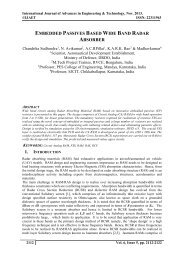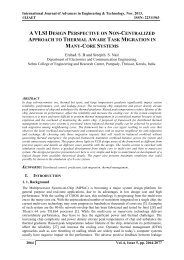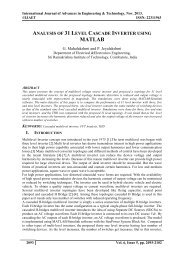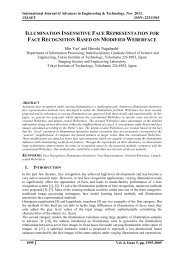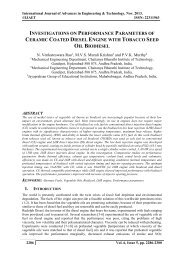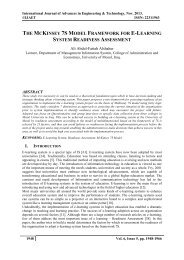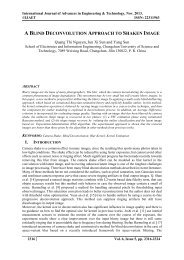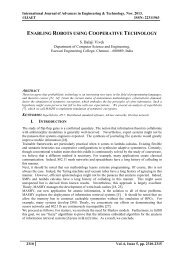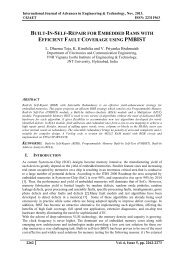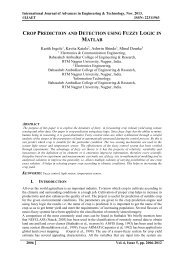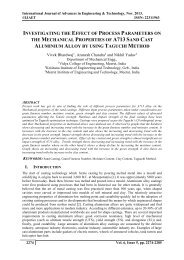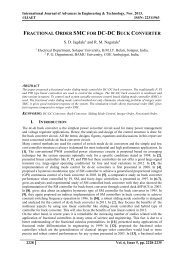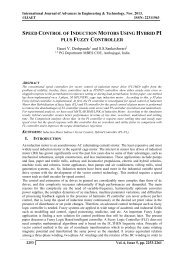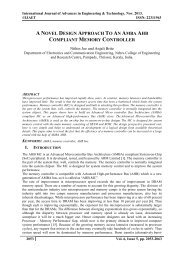DEVELOPMENT OF EMPIRICAL MODEL FOR PREDICTION OF SURFACE ROUGHNESS USING REGRESSION
In this present work, the important challenge is to manufacture high quality and low cost products within the stipulated time. The quality is one of the major factors of the product which depends upon the surface roughness and hence the surface roughness placed an important role in product manufacturing. Hence, an Empirical model is proposed for prediction of surface roughness in machining processes at given cutting conditions. The model considers the following working parameters spindle speed, feed, depth of cut, number of flutes and overhang of the tool. For a given work-tool combination, the range of cutting conditions are selected from different cutting condition variables. The experiments were conducted based on the principle of Factorial Design of Experiment (DOE) method with mixed level. After conducting experiments, surface roughness values are measured. Then these experimental results are used to develop an Empirical model for prediction of surface roughness by using Multiple Regression method. In this the Artificial Intelligence based neural network modelling approach is presented for the prediction of surface roughness of Aluminium Alloy products machined on CNC End Milling using High speed steel tool. Trails were made with different combinations of step size and momentum to select the best learning parameter. The best network structure with least Mean Square Error (MSE) was selected among the several networks. The multiple regression models, which are most widely used as prediction methods, are considered to be compared with the developed Artificial Neural Network (ANN) model performance.
In this present work, the important challenge is to manufacture high quality and low cost products within the stipulated time. The quality is one of the major factors of the product which depends upon the surface roughness and hence the surface roughness placed an important role in product manufacturing. Hence, an Empirical model is proposed for prediction of surface roughness in machining processes at given cutting conditions. The model considers the following working parameters spindle speed, feed, depth of cut, number of flutes and overhang of the tool. For a given work-tool combination, the range of cutting conditions are selected from different cutting condition variables. The experiments were conducted based on the principle of Factorial Design of Experiment (DOE) method with mixed level. After conducting experiments, surface roughness values are measured. Then these experimental results are used to develop an Empirical model for prediction of surface roughness by using Multiple Regression method. In this the Artificial Intelligence based neural network modelling approach is presented for the prediction of surface roughness of Aluminium Alloy products machined on CNC End Milling using High speed steel tool. Trails were made with different combinations of step size and momentum to select the best learning parameter. The best network structure with least Mean Square Error (MSE) was selected among the several networks. The multiple regression models, which are most widely used as prediction methods, are considered to be compared with the developed Artificial Neural Network (ANN) model performance.
You also want an ePaper? Increase the reach of your titles
YUMPU automatically turns print PDFs into web optimized ePapers that Google loves.
International Journal of Advances in Engineering & Technology, Nov. 2013.<br />
©IJAET ISSN: 22311963<br />
Aluminium alloy (Si-0.6 to 1.3, Fe-0.6, Cu-0.1, Mn-0.4 to 1.0, Cr-0.25, Zi-0.1, Ti-0.2, and Mg-0.4 to<br />
1.2). The cutting tool with carbide inserts (CCMW 9030) is used to machine the work piece material.<br />
The response of surface roughness was measured by using Mitutoyo Surftest-211 instrument and the<br />
results are tabulated in table 2.<br />
Test<br />
No.<br />
v(rpm)<br />
f(mm/r<br />
ev)<br />
d<br />
(mm)<br />
Table 2: Experimental Results (Train Data)<br />
nf<br />
ol<br />
(mm)<br />
Ra<br />
(μm)<br />
2043 Vol. 6, Issue 5, pp. 2041-2052<br />
Test<br />
No.<br />
v(rpm)<br />
f(mm/<br />
rev)<br />
d<br />
(mm)<br />
nf<br />
ol<br />
(mm<br />
)<br />
1 2000 160 0.5 2 35 1.747 25 2000 160 0.5 4 35 4.777<br />
2 2000 160 0.8 2 35 1.537 26 2000 160 0.8 4 35 4.773<br />
3 2000 240 0.8 2 35 1.717 27 2000 240 0.8 4 35 7.087<br />
4 2000 240 0.5 2 35 1.563 28 2000 240 0.5 4 35 6.31<br />
5 2500 160 0.5 2 35 1.46 29 2500 160 0.5 4 35 3.947<br />
6 2500 160 0.8 2 35 1.513 30 2500 160 0.8 4 35 4.403<br />
7 2500 240 0.8 2 35 1.677 31 2500 240 0.5 4 35 5.393<br />
8 2500 240 0.5 2 35 1.653 32 2500 240 0.8 4 35 5.75<br />
9 3000 160 0.8 2 35 0.823 33 3000 160 0.8 4 35 3.213<br />
10 3000 160 0.5 2 35 0.587 34 3000 160 0.5 4 35 2.797<br />
11 3000 240 0.8 2 35 1.623 35 3000 240 0.8 4 35 2.707<br />
12 3000 240 0.5 2 35 1.657 36 3000 240 0.5 4 35 2.54<br />
13 2000 160 0.8 2 30 2.497 37 2000 160 0.8 4 30 2.04<br />
14 2000 160 0.5 2 30 2.49 38 2000 160 0.5 4 30 2.353<br />
15 2000 240 0.5 2 30 3 39 2000 240 0.5 4 30 2.847<br />
16 2000 240 0.8 2 30 4.07 40 2000 240 0.8 4 30 3.167<br />
17 2500 160 0.5 2 30 1.58 41 2500 160 0.8 4 30 1.21<br />
18 2500 160 0.8 2 30 1.5 42 2500 160 0.5 4 30 0.97<br />
19 2500 240 0.5 2 30 4.193 43 2500 240 0.8 4 30 2.437<br />
20 2500 240 0.8 2 30 4.057 44 2500 240 0.5 4 30 2.73<br />
21 3000 160 0.5 2 30 2.55 45 3000 160 0.8 4 30 0.947<br />
22 3000 160 0.8 2 30 2.493 46 3000 160 0.5 4 30 1.257<br />
23 3000 240 0.8 2 30 3.86 47 3000 240 0.5 4 30 2.86<br />
24 3000 240 0.5 2 30 4.26 48 3000 240 0.8 4 30 3.203<br />
IV.<br />
<strong>SURFACE</strong> <strong>ROUGHNESS</strong> <strong>MODEL</strong><br />
The purpose of developing the mathematical models relating the machining responses and their<br />
machining factors is to facilitate a functional relationship between surface roughness and the<br />
independent variables (v, f, d, nf, ol). The following models are considered in this section.<br />
4.1 Multiple Regression Model<br />
The multiple regression models were developed by using the independent variables (v, f, d, nf, ol) and<br />
the dependent variable (Ra). The experimental results were modeled using multiple regression<br />
methodology and respective models excluding and including interaction terms were developed.<br />
The equation excluding interaction terms using independent variables [5].<br />
For simplicity, equation is re-written as algebraic representation of regression line can be represented<br />
by<br />
Ra = b0+b1x1+b2x2+b3x3+b4x4+b5x5 ……………(1)<br />
Where, Ra is surface roughness; x1,x2,x3,x4,x5 are predictors and b0,b1,b2,b3,b4,b5 are the<br />
regression coefficients.<br />
Using the experimental data, the analysis consisted of estimating these five variables first for first<br />
order model. If the first order model demonstrates any statistical evidence of lack of fit, a second<br />
order model can then be developed using additional data, this model is an algebraic model with<br />
interaction terms are considered. The Multiple regression equation of second order model with<br />
interaction terms can be represented by the fallowing equation.<br />
R=b0+b1x1+b2x2+b3x3+b4x4+b5x5+b6x1x2+b7x1x3+b8x1x4+b9x1x5+b10x2x3+b11x2x4+b12x2<br />
x5+b13x3x4+b14x3x5+b15x4x5+b16x12+b17x22+b18x32+b19x42+b20x52 …………………..(2)<br />
Ra<br />
(μm)




